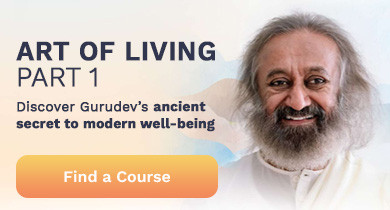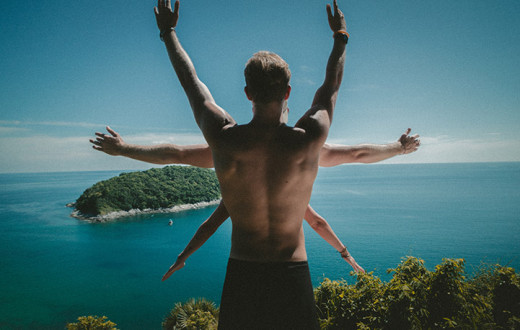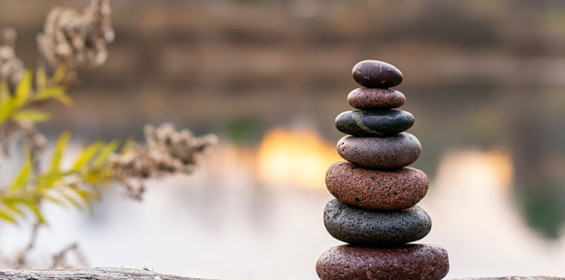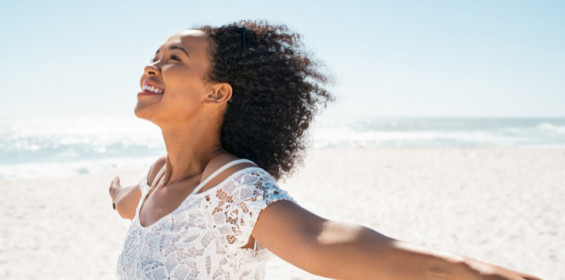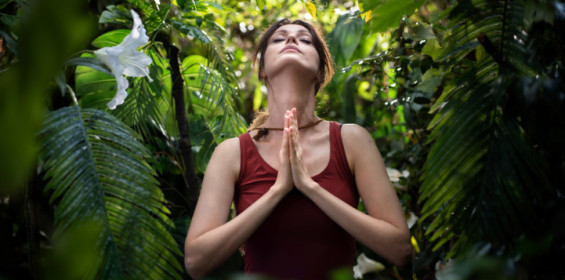
If you're looking for a simple, enjoyable way to start your day that provides a diverse range of health benefits, consider practicing Sun Salutations. The traditional sun salutation is a special sequence of yoga postures accompanied by specific breathing patterns. With all kinds of physical, mental, and spiritual benefits, a Sun Salutation practice is the perfect start to your day—especially if you have limited time and you want a full body, mind, and spirit workout!
Known in Sanskrit as Surya Namaskar (Sur-yah-Namah-skar), this sequence of twelve yoga poses is thousands of years old. Keep reading to learn more about this ancient, powerful practice.
Difficulty: Beginner to intermediate
The yogic science and spirituality behind Sun Salutations

It has been said that the different parts of the body are governed by different Devas (deity or divine light). The Solar plexus (located behind the navel, which is the central point of the human body) is said to be connected with the Sun, which is why it is called the solar plexus. When the first rays of the sun fall on the solar plexus, it is very good for your body. This is why it is good to do Surya Namaskar (Sun Salutations) in the early morning. Ancient Rishis recommended the practice of Surya Namaskar because this sequence expands the solar plexus, which increases one’s creative and intuitive abilities.
The solar plexus has a profound impact on the central nervous system, optic nerves, stomach, and what we usually call our “gut feeling.” It is the second brain in our body. When the solar plexus contracts, you can feel sad, depressed, or have other negative feelings. When the solar plexus expands, the intuitive mind awakens, and the mind becomes clear and focused.
World-renowned spiritual leader and master of meditation, Gurudev Sri Sri Ravi Shankar, says, “All our emotions get stored in the solar plexus, and it is also the point where one's gut feelings arise. The size of the solar plexus is said to be like the size of a small gooseberry. However, for those who do yoga, meditation, and Sudarshan Kriya breathwork, it becomes much bigger - almost three to four times bigger than the normal size. The more expanded your solar plexus, the greater is your mental stability and your intuition.”
Sun Salutation benefits

With regular practice, Sun Salutations can yield:
Improved cardiovascular health and circulation
Improved metabolism
Increased flexibility
Improved balance and coordination
Increased strength
Reduced stress and anxiety
Improved mindfulness and well-being
Precautions

Back injuries
Injuries to the shoulders, arms, or wrists
Abdominal surgery
Pregnancy
Preparatory poses

Child’s Pose
Cat Cow Pose
Marching in place or dancing
Step-by-step guide: Pose-by-pose
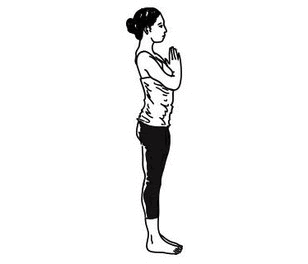
One round of the Sun Salutation sequence consists of two sets, the first leading with the right leg and the second leading with the left in the fourth and ninth positions. Start by doing two to four rounds and gradually build up to twelve rounds.
Prayer Pose

Stand at the edge of your yoga mat, keep your feet together, and balance your weight equally on both feet.
Expand your chest and relax your shoulders.
As you inhale, lift both arms up from the sides. As you exhale, bring your palms together in front of the chest in a prayer position.
Benefits:
Establishes a state of humility, gratitude, concentration, and calmness
Helps maintain body balance and relaxes the nervous system
Raised Arms Pose

As you inhale, lift the arms overhead, keeping the biceps close to the ears. In this pose, the effort is to stretch the whole body up from the heels to the tips of the fingers.
To deepen the stretch, push the pelvis forward a little bit. Ensure that you reach up with your fingers rather than trying to bend backward.
Benefits:
Stretches the abdominal and intestinal muscles, arms, and spinal cord
Expands the chest, resulting in a full intake of oxygen
Standing Forward Bend

Breathing out, stretch forward, and bend downwards from the waist, keeping the spine erect.
As you exhale completely, bring your hands down to the floor beside your feet to come into Standing Forward Bend.
You may bend the knees, if necessary, to bring the palms down to the floor.
To deepen the stretch, straighten the knees.
Benefits:
Tones abdomen, muscles of thighs, and legs
Stretches the spine and back muscles
Opens the hips and shoulders
Equestrian Pose

Breathing in, push your right leg back as far as possible.
Bring the right knee to the floor and look up.
The left foot is in between the palms.
Benefits:
Tones abdomen, muscles of thighs, and legs
Makes the spine and neck flexible
Good for indigestion, constipation, and sciatica
Plank Pose

As you breathe in, take the left leg back and bring the whole body in a straight line.
Keep your arms perpendicular to the floor.
Benefits:
Strengthens arms, back, and abdominal muscles
Helps cure certain problems in the spinal column and cord
Improves posture
Calms the mind
Eight Points Salute

Gently bring your knees down to the floor and exhale. Take the hips back slightly as in a child's pose, then slide forward.
Rest your chest and chin on the floor. Raise your posterior slightly.
The two hands, two feet, two knees, and chest and chin should touch the floor. Abdomen remains off the floor.
Benefits:
Strengthens the nerves and muscles of the shoulders, arms, back, and chest
Enhances the flexibility of the back and spine
Reduces tension and anxiety
Cobra Pose

Slide forward and raise the chest up into the Cobra Pose.
You may keep your elbows bent in this pose with the shoulders away from the ears. Look up.
As you inhale, gently push the chest forward. As you exhale, gently push the navel down. Keep the toes flat on the floor.
Benefits:
Benefits the adrenal glands and kidneys, sending them a richer supply of blood
Tones ovaries, uterus, and liver
Strengthens the muscles of the back, abdomen, and entire upper body
Aids menstrual irregularities
Relieves constipation
Elevates mood
Invigorates the heart
Alternatively, you could do Upward-Facing Dog.
Downward-Facing Dog Pose

Breathing out, lift the hips and the tail bone up, chest downwards in an 'inverted V' (/\) posture, Downward-Facing Dog.
How to deepen this yoga stretch?
If possible, try to keep the heels on the ground and make a gentle effort to lift the tailbone up, going deeper into the stretch.
Benefits:
Stretches arm, back, and abdominal muscles
It can help remedy certain problems with the spinal column and cord
Increases blood flow to the brain and head region
Equestrian Pose

Breathing in, bring the right foot forward between the two hands, the left knee down to the floor, press the hips down, and look up.
Place the right foot exactly between the two hands and the right calf perpendicular to the floor. In this position, make a gentle effort to push the hips down towards the floor to deepen the stretch.
Standing Forward Bend

Breathing out, bring the left foot forward. Keep the palms on the floor. You may bend the knees if necessary.
Gently straighten the knees, and if you can, try touching your nose to the knees. Keep breathing.
Raised Arms Pose

Breathing in, roll the spine up, hands go up, and bend backward a little bit, pushing the hips slightly outward.
Ensure that your biceps are beside your ears. The idea is to stretch up more rather than stretching backward.
Mountain Pose

On your next exhalation, first, straighten your body, then bring your arms down. Relax in Mountain Pose and observe the sensations in your body.
Benefits:
Helps maintain the balance of the body
Relaxes the nervous system
Before you start practicing Sun Salutations, download our FREE e-book, Sun Salutation: Your Full Guide to Master the Age-old Yoga Sequence, and learn how you can prepare yourself for doing the 108 Sun Salutations challenge! The e-book also contains beautiful audio of powerful Surya Namaskar mantras.
If you would like help with Sun Salutations from our yoga teachers, visit our Online Yoga Studio.
Follow-up poses

Enhance your yoga practice with SKY Breath Meditation

When practiced regularly, breathing and meditation supercharge yoga's life benefits. To get the most out of your yoga practice, add Sudarshan Kriya, also known as SKY Breath Meditation.
SKY practitioners report:
Greater mental focus
Healthier blood pressure
Enhanced deep sleep
Mental fortitude
Increased joy and optimism
Decreased stress, anxiety, and depression
Register for the Art of Living Part 1 course to learn SKY today!
Related articles and other poses

Wheel Pose: Gain Flexibility, Open Heart, Release Sadness
Shoulder Stand: Strengthen Your Spine and Core Muscles Today
Bow Pose: Expand Your Chest and Stretch Those Hip Flexors!
Camel Pose: Improve Your Posture and Open Your Heart Center
Vajrasana: The Yoga Pose to Use During Breathing Exercises
Warrior Pose: Gain Hip Flexibility and Inner Strength Now
Triangle Pose: Improve Your Balance, Reduce Back Pain Today
Tree Pose: Live Longer By Balancing On One Foot?
Butterfly Pose: One of the Best Remedies for Too Much Sitting
Chair Pose: Taking This Seat Strengthens Your Whole Body
Sphinx Pose: The Heart-Forward Back Bend for More Flexibility
Superman Pose: Tone Your Back and Abdomen Muscles and FLY!
Plow Pose: Increase Your Flexibility and Build Strength Now
Sukshma Yoga: This Gentle Yoga Can Relax You in 7 Minutes, Try Anytime
Padma Sadhana: Learn and Master this Beautiful Yoga Sequence Today
Seated Forward Bend with Adi Mudra (Yoga Mudra)
Bridge Pose: An Easy Gluteus Maximus Workout
Fish Pose: Gain Spinal Flexibility with This Chest Opener Pose
Eagle Pose: A Standing Body Twist for Increasing Balance
Reverse Prayer Pose: A Heartfelt Shoulder and Chest Expander
Standing Backward Bend (Ardha Chakrasana)
Standing Spinal Twist (Katichakrasana)
Standing Wide-Legged Forward Bend (Prasanta Padottanasana)
Cat Cow Pose: Stretch and Breathe to a More Flexible Spine
Forward Lunge (Ashwasanchalanasana)
Upward Plank Pose (Poorvottanasana)
Lotus Pose: An Advanced Pose for Yogis and Yoginis Everywhere
Mill Churning Pose: Chakki Chalanasana)
Monkey Pose: Use This Splits Pose for a Deep Hip Opener
One-Legged Forward Bend (Janu Shirasana)
Two-Legged Sitting Forward Bend (Paschimottanasana)
Pigeon Pose: Want More Flexible Hips? This is Your Pose!
Sitting Half Spinal Twist (Ardha Matsyendrasana)
Crocodile Pose: Release Tension From the Whole Body
Locust Pose: Gain Spinal Flexibility and Better Digestion
Boat Pose: Set Sail For a Stronger Upper Body and Lower Belly
Legs-Up-The-Wall Pose (Viparita Karani)
Lying-down Body Twist (Natrajasana)
Wind-Relieving Pose (Pavanamuktasana)
Lying Down on Sides (Vishnuasana)
Are you interested in becoming a 200H certified yoga teacher?

Sri Sri School of Yoga offers traditional (scripture-based), classical, and authentic teacher training programs globally. Our programs are Yoga Alliance certified. To learn more about teacher training offered in North America, click here!

